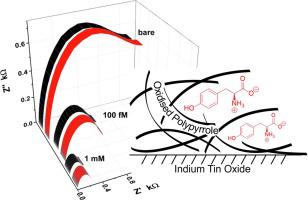Electrochemistry Communications ( IF 5.4 ) Pub Date : 2020-06-27 , DOI: 10.1016/j.elecom.2020.106782 Souradeep Roy , Shalini Nagabooshanam , Shikha Wadhwa , Nidhi Chauhan , Ashish Mathur , Saif A. Khan , James Davis

|
It has been found that the concentration of l-tyrosine is greatly elevated within infected ulcers and thus there is a pressing need for sensors that can aid the point of care monitoring of this potential biomarker. In this work, a templated over-oxidised polypyrrole film on indium tin oxide is exploited as a sensitive sensing system, for the detection of tyrosine. The sensor has been characterised using a variety of surface techniques (contact angle, FTIR, SEM) and the electrochemical properties explored using cyclic voltammetry (CV) and electrochemical impedance spectroscopy (EIS). The sensor was found to exhibit a substantial linear range (100 fM–1 mM) with limits of detection of 1.73 pM (CV) and 6.63 pM (EIS). The sensor demonstrated rapid response characteristics (less than 1 min) and high stability (up to 3 months).
中文翻译:

使用分子印迹电化学传感器对糖尿病足溃疡进行超灵敏检测l-酪氨酸
已经发现l的浓度-酪氨酸在感染的溃疡中大大升高,因此迫切需要传感器,以帮助对这种潜在生物标志物进行现场监测。在这项工作中,利用氧化铟锡上的模板化过氧化聚吡咯膜作为灵敏的传感系统,用于检测酪氨酸。该传感器已使用多种表面技术(接触角,FTIR,SEM)进行了表征,并使用循环伏安法(CV)和电化学阻抗谱(EIS)探索了电化学性能。发现该传感器具有很大的线性范围(100 fM–1 mM),检出限为1.73 pM(CV)和6.63 pM(EIS)。该传感器表现出快速响应特性(少于1分钟)和高稳定性(长达3个月)。



























 京公网安备 11010802027423号
京公网安备 11010802027423号